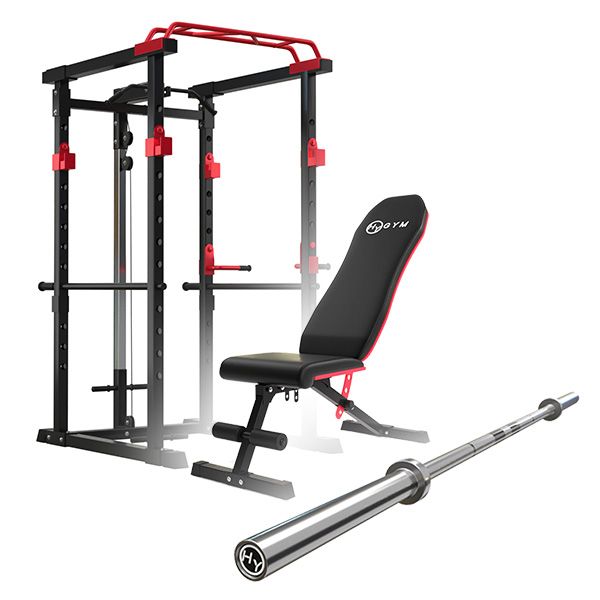Finding the right balance between consistency and variety in your workout routine can be a challenging task. It’s a question that often lingers in the minds of fitness enthusiasts and beginners alike – how often should I change my workout routine? While sticking to a routine is essential for progress, introducing some changes at regular intervals can help prevent plateaus and keep you motivated. In this article, we will explore the factors to consider when determining how frequently to switch up your workouts, providing you with valuable insights to optimize your fitness journey.
Table of Contents
ToggleFactors to consider
Current fitness level
When determining how often to change your workout routine, it’s important to consider your current fitness level. If you’re just starting out or recovering from an injury, you may need to stick with the same routine for a longer period of time to build a solid foundation. On the other hand, if you’re already at an advanced fitness level, you may need to change your routine more frequently to continue challenging your body and avoid plateauing.
Goals
The goals you have for your fitness journey will also play a role in how often you should change your workout routine. If your goal is to build strength and muscle, you may need to stick with a routine that focuses on progressive overload and targeting specific muscle groups for a longer duration. However, if your goal is to improve cardiovascular fitness or lose weight, incorporating variety and changing your routine more frequently may be beneficial.
Time availability
Another factor to consider is your time availability. If you have a busy schedule and can only commit to a few workouts per week, changing your routine too often may not be practical. In this case, it may be more effective to stick with a consistent routine that you can easily fit into your schedule. On the other hand, if you have plenty of time available for workouts, changing your routine more frequently can help keep things interesting and prevent boredom.
Variety and boredom
One of the benefits of changing your workout routine is the ability to introduce variety and prevent boredom. Doing the same exercises and routine day after day can lead to a lack of motivation and enjoyment. By changing your routine, you can incorporate new exercises, try different types of workouts, and keep things fresh and exciting. This can help you stay motivated and engaged in your fitness journey.
Plateauing
Plateauing is a common challenge that many individuals face in their fitness journey. When you reach a plateau, it means that your progress has stalled and you’re no longer seeing improvements in your strength, endurance, or body composition. Changing your workout routine can help prevent plateauing by challenging your muscles in new ways, forcing them to adapt and continue to make progress. By introducing variety and changing your routine, you can break through plateaus and continue to see results.
Benefits of changing workout routines
Prevention of plateauing
One of the main benefits of changing your workout routine is the prevention of plateauing. As mentioned earlier, repeating the same exercises and routine for an extended period of time can lead to a plateau in your progress. By changing your routine, you can challenge your body in new ways, recruit different muscle fibers, and continue to make gains in strength, endurance, or other fitness goals.
Muscle confusion
Changing your workout routine regularly can also lead to muscle confusion. When you perform the same exercises repeatedly, your muscles become efficient at those movements and adapt accordingly. However, by introducing new exercises and varying your routine, you can keep your muscles guessing and prevent them from adapting too quickly. This can lead to continued improvements in muscle strength, size, and overall performance.
Improved motivation
Sticking to the same workout routine for an extended period of time can sometimes lead to a lack of motivation. It’s only natural to become bored or lose interest when there’s no variety or excitement in your workouts. By changing your routine, you can inject new energy and motivation into your fitness journey. Trying out new exercises, challenging yourself in different ways, and exploring new workout formats can reignite your passion and keep you motivated to continue pushing yourself.
Avoiding overuse injuries
Overuse injuries are common among individuals who engage in the same repetitive movements for prolonged periods of time. By changing your workout routine, you can reduce the risk of overuse injuries by giving certain muscle groups a break and allowing others to work. Additionally, by incorporating a variety of exercises that target different muscle groups, you can ensure that no single muscle group is being excessively stressed, reducing the risk of overuse and chronic injuries.
Exploring new exercises
Changing your workout routine allows you the opportunity to explore new exercises and workout formats. Perhaps you’ve always wanted to try yoga or high-intensity interval training (HIIT), but never had the chance. By introducing new exercises into your routine, you can discover new passions and find exercises that you genuinely enjoy. This not only keeps your workouts interesting and enjoyable, but it also expands your fitness horizons and opens up a world of possibilities.
When to change your workout routine
When you’re no longer seeing progress
One key indicator that it’s time to change your workout routine is when you’re no longer seeing progress towards your fitness goals. If you’ve been following the same routine for several weeks or months and have reached a point where your progress has stalled, it may be time for a change. By introducing new exercises, increasing the intensity, or modifying the volume of your workouts, you can push past plateaus and continue making progress.
When you’ve reached your goals
Another sign that it’s time to change your workout routine is when you’ve achieved your initial fitness goals. If you set out to run a marathon and successfully complete it, it’s natural to shift your focus and set new goals. By changing your routine and pursuing new challenges, you can continue to grow and evolve as an athlete. This allows you to maintain your motivation and avoid slipping into a state of complacency.
When you’re getting bored or unmotivated
Our bodies and minds thrive on variety and novelty. If you find yourself getting bored or unmotivated with your workouts, it’s a clear sign that a change is needed. Instead of dreading your workouts, embrace the opportunity to try something new and inject excitement back into your fitness routine. By exploring different exercises, workout formats, or even joining group fitness classes, you can reignite your passion and enthusiasm for fitness.
When your schedule allows for change
Sometimes, the reason to change your workout routine is simply because your schedule allows for it. If you’ve had a recent shift in your work or personal life that provides more flexibility in your daily schedule, take advantage of it by introducing a change in your routine. This could mean adding in extra workouts, trying new activities during your free time, or exploring different fitness classes that fit into your new schedule.
When you want to try something new
There’s no rule that says you have to stick to the same workout routine forever. If you have the desire to try something new, whether it’s a specific sport, a different style of training, or a unique exercise that has caught your attention, go for it! Changing your workout routine to accommodate your interests and curiosity can lead to a renewed sense of excitement and passion for fitness.
How often to change your workout routine
Every 4-6 weeks
A general guideline for changing your workout routine is to do so every 4-6 weeks. This allows enough time for your body to adapt and make progress, while also introducing enough variety to prevent plateaus. By changing your routine every 4-6 weeks, you can keep your workouts fresh and challenging, while still allowing enough time for your body to adapt to new movements and stimuli.
Every 8-12 weeks
For individuals who are more advanced or have specific training goals, changing your workout routine every 8-12 weeks may be more appropriate. This longer time frame allows for a greater focus on specific training adaptations and goals before introducing new exercises or training methods. By extending the duration between routine changes, you can keep your training more consistent and make more substantial progress within each phase.
Every 3 months
Another option for changing your workout routine is to do so every 3 months. This time frame allows for a good balance between keeping workouts fresh and allowing for adaptation. With a 3-month time frame, you can dive deeper into specific training phases or programs, which can be beneficial for individuals with more specific goals or those who prefer a structured approach to their training.
Listen to your body’s cues
While these general guidelines can be helpful, it’s important to remember that everyone’s body is different, and individual needs may vary. It’s crucial to listen to your body’s cues and adjust your routine accordingly. If you’re feeling excessively fatigued, experiencing persistent muscle soreness, or noticing a decline in performance, it may be a sign that you need to change your routine sooner than planned. On the other hand, if you’re still making progress and enjoying your workouts, you may not need to change your routine as frequently.
Consider professional guidance
If you’re unsure about how often to change your workout routine or need guidance on structuring your training, it can be helpful to consult with a fitness professional. A personal trainer or exercise specialist can assess your goals, current fitness level, and individual needs to provide tailored recommendations on routine changes. They can also help you design a periodized training program that incorporates a strategic progression of exercises, volume, and intensity to maximize your results.
Tips for effective routine changes
Set clear goals
Before making any changes to your workout routine, take the time to define clear goals. Whether it’s improving strength, increasing endurance, or losing weight, having specific objectives in mind will guide your decision-making process. These goals will determine the types of exercises, training techniques, and workout formats that are most appropriate for your routine changes.
Incorporate new exercises gradually
When changing your workout routine, it’s important to introduce new exercises gradually. Sudden and drastic changes can increase the risk of injury and hamper your progress. Instead, start by incorporating one or two new exercises into your routine and gradually build from there. This allows your body to adapt to the new movements and minimizes the chance of overload or excessive muscle soreness.
Progressively increase intensity and volume
As you become more comfortable with the new exercises and routines, it’s important to progressively increase the intensity and volume of your workouts. This may involve increasing the weight you lift, the number of reps and sets you perform, or the duration and intensity of your cardio workouts. By gradually challenging your body, you can continue making progress and avoid stagnation.
Monitor and track your progress
To ensure that your routine changes are effective, it’s essential to monitor and track your progress. Keep a workout journal or use a fitness tracking app to record your exercises, sets, reps, weights, and any other relevant data. This allows you to objectively assess your progress and make adjustments as needed. If certain exercises aren’t producing the desired results or you’re not seeing improvements in specific areas, it may be time to modify your routine.
Periodize your training
Periodization involves organizing your training into distinct phases or cycles, each with a specific focus and goal. By implementing a periodization plan, you can strategically change your workout routine at predetermined intervals to optimize your progress. This may involve shifting between different training modalities (e.g., strength, endurance, power), manipulating training volume and intensity, or targeting different muscle groups. Periodization helps prevent stagnation, ensures balanced development, and improves overall performance.
Examples of workout routine changes
Switching between strength and cardio focus
One way to change your workout routine is by alternating between strength and cardio-focused periods. For example, you could spend 4-6 weeks focusing on strength training, followed by a 4-week period where the emphasis shifts to cardiovascular endurance. This approach allows for well-rounded fitness development, prevents boredom, and accommodates different training goals.
Trying different types of workouts (HIIT, yoga, Pilates)
Incorporating different types of workouts into your routine is an excellent way to introduce variety and challenge your body in new ways. High-intensity interval training (HIIT), yoga, Pilates, dance classes, and outdoor activities are just a few examples of the countless options available. By trying different workouts, you can discover new forms of movement that you enjoy and stimulate different muscle groups to enhance overall fitness.
Changing training splits and muscle groups targeted
Another way to change your workout routine is by modifying your training splits and the specific muscle groups you target. If you’ve been focusing primarily on full-body workouts, you could switch to a split routine that targets different muscle groups on different days. This allows for greater intensity and specialization, providing unique challenges to overcome and promoting balanced muscular development.
Adding in new equipment or props
Adding new equipment or props to your workouts can help keep your routine fresh and exciting. Whether it’s incorporating resistance bands, kettlebells, stability balls, or TRX suspension trainers, the introduction of new tools can add variety and increase the challenge of your exercises. This not only keeps your workouts interesting but can also enhance muscle activation and engagement.
Joining a group fitness class
Joining a group fitness class is a fantastic way to change your workout routine and tap into the motivational benefits and community atmosphere of exercising with others. Group classes can offer a wide range of formats, from cycling and kickboxing to boot camps and Zumba. By participating in these classes, you can learn new techniques, receive guidance from qualified instructors, and have fun while working out.
Risks of changing your routine too frequently
Lack of progress and consistency
While changing your workout routine is essential for continued progress, changing it too frequently can hinder your results. Your body needs time to adapt and make improvements in strength, endurance, and other fitness parameters. If you change your routine too frequently, you may not give yourself enough time to experience the benefits of the exercises or cultivate consistent habits.
Increased risk of injury
Rapidly changing your routine without considering proper progression and technique can increase the risk of injury. Your muscles, tendons, and joints need adequate time to adapt to new movements and loads. Frequent changes without allowing your body to adapt can overload certain structures and lead to overuse injuries or acute trauma. It’s important to prioritize safety and gradual progression in your routine changes.
Lack of mastery and skill development
When you continuously switch between exercises and training methods, it can be challenging to develop mastery and proficiency in specific movements. Consistency and practice are key to refining your technique and maximizing your performance. By constantly changing your routine, you may miss out on the opportunity to become highly skilled in certain exercises or movements.
Mental and physical fatigue
Constantly changing your workout routine can lead to mental and physical fatigue. The constant need to learn new exercises, adapt to new movements, and adjust to different training intensities can be overwhelming. This can lead to decreased motivation, increased stress, and a higher risk of burnout. It’s important to find a balance between variety and consistency to avoid excessive fatigue.
Difficulty in tracking progress
Regularly changing your workout routine can make it more challenging to track your progress accurately. When exercises, intensities, or training modalities are consistently changing, it becomes more difficult to objectively assess improvements in strength, endurance, or body composition. Tracking progress is crucial for staying motivated and ensuring that your routine changes are effective.
Individual considerations
Recovery and rest needs
Everyone’s recovery and rest needs differ based on various factors, such as age, fitness level, and overall health. It’s crucial to listen to your body and allow adequate rest and recovery time between workouts. If you find that your routine changes are causing excessive fatigue, muscle soreness, or a decline in performance, it may be a sign that you need to adjust the frequency or intensity of your workouts.
Training experience and background
Your training experience and background also play a role in determining how often you should change your workout routine. Beginners and individuals new to exercise may require longer periods of time to become accustomed to new exercises and develop a solid foundation. In contrast, individuals with more experience may need to change their routine more frequently to continue challenging their bodies and achieving new goals.
Injury history and limitations
Individuals with a history of injuries or specific limitations may need to approach routine changes with caution. It’s essential to consider any previous injuries or areas of weakness when designing a new workout routine. Incorporating exercises that address these limitations and avoiding movements that exacerbate existing injuries is crucial to ensure safety and promote proper healing.
Personal preferences and enjoyment
Your personal preferences and enjoyment are an important consideration when changing your workout routine. Some individuals thrive on variety and enjoy trying new exercises and workouts regularly. Others may prefer consistency and find comfort in sticking to a familiar routine. It’s important to find a balance that allows you to enjoy your workouts while still challenging yourself and achieving your goals.
Specific sport or event training
If you’re training for a specific sport or event, your routine changes will likely be influenced by the demands of that activity. Sports and events often require specific skills, strength, and conditioning, which may necessitate a more structured and strategic approach to your training. Consulting with a sports-specific coach or trainer can help you tailor your workouts and routine changes to optimize your performance in your chosen activity.
Conclusion
When it comes to changing your workout routine, there is no one-size-fits-all answer. It’s essential to consider several factors, such as your current fitness level, goals, time availability, and desire for variety. Changing your routine can provide numerous benefits, including preventing plateauing, muscle confusion, improved motivation, injury prevention, and the opportunity to explore new exercises. The frequency of routine changes can vary, with general recommendations ranging from every 4-6 weeks to every 3 months. However, it’s crucial to listen to your body’s cues and seek professional guidance if needed. Ultimately, finding what works best for you and regularly assessing and adjusting your routine will help you stay motivated, make progress, and enjoy your fitness journey.









